By James Heinz
Since 1799, five American warships have proudly carried the name ESSEX. Shortly before his death Abraham Lincoln authorized construction of USS ESSEX #3. She was not completed until 1876. She was designed by famous shipbuilder Donald McKay, who also designed the famous clipper ship FLYING CLOUD.
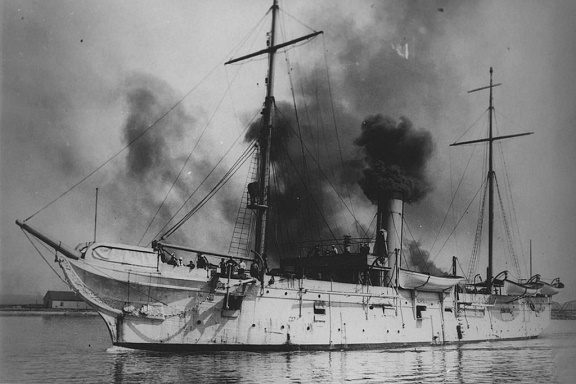
The ESSEX in 1912. Great Lakes Marine Collection of the Milwaukee Public Library and Wisconsin Marine Historical Society
Having revolutionized warship design during the Civil War by the use of ironclad, fully steam powered vessels equipped with rotating gun turrets, ESSEX would seem like a giant step backward. She was a wooden sailing vessel equipped with an auxiliary steam engine and a screw propeller.
However, she was designed to “show the flag” in remote parts of the world where it would be easier to repair a wooden ship. American naval doctrine called for the US Navy in event of war to act as commerce raiders against a superior European navy, and a ship powered primarily by wind would be harder to track down than a steamship which required constant trips into port to refuel.
Photo at top of page: The ESSEX in the Detroit River in 1905. Great Lakes Marine Collection of the Milwaukee Public Library and Wisconsin Marine Historical Society
The ESSEX was a three masted barque rigged vessel with a compound steam engine, a retractable smoke stack, and a speed of 10 knots. She displaced 1,379 tons, was 185 feet long and 35 feet wide and was armed with one 11 inch and four 9 inch guns and one 60 pound gun.
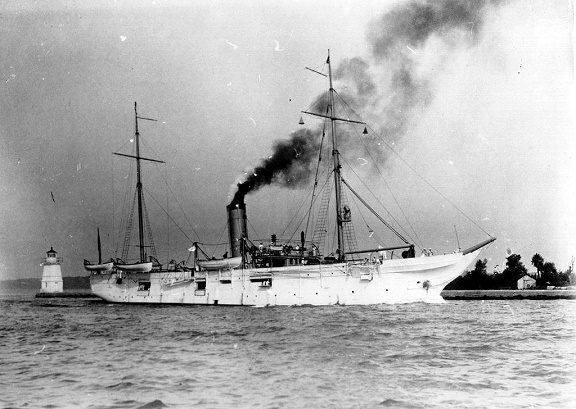
The ESSEX in 1913 courtesy of Wikipedia
The following is Wikipedia’s description: ”Essex had a very bluff appearance; she had a figurehead, a moderate tumble home and a shapely rounded stern. She also had a bowsprit, a jib boom and also a flying jib boom. USS Essex was also believed to have copper sheathing on her bottom.”
She was assigned to the Atlantic Ocean until 1879 and then to the Pacific Ocean until 1889 when she returned home and was given to the Naval Academy. In 1904 she was loaned to the Ohio Naval Militia.
As I noted in a previous article, https://wmhs.org/the-mysterious-disappearing-warship-of-the-kinnickinnic-river/ Wikipedia tells us: “A naval militia is a reserve military organization administered under the authority of a state government in the United States.” It should not be confused with the Naval Reserve or the Coast Guard Auxiliary, which are under direct federal control.
Why were these militias established? “In the 1880s, a US Navy proposal to organize a national Naval Reserve Force was submitted to Congress, but the proposal was defeated. However, the movement to create a naval reserve force became popular at the state level. Several states began establishing naval reserve forces (including Wisconsin). The US Navy began loaning older veteran ships to these state naval militias.” The Naval Reserve as we know it was not established until 1938.
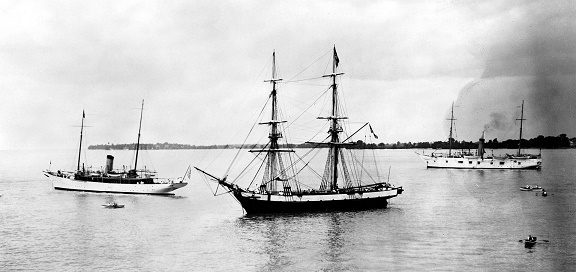
The ESSEX with the Brig NIAGARA at the 1913 Battle of Lake Erie courtesy of Wikipedia
By the time the Navy turned the ESSEX over to Ohio, her engines no longer functioned so she used her sails. Once she almost collided with another ship in fog and in 1904 she ran aground in the mouth of the Saguenay River, Quebec. In 1910 her engine was replaced with a more modern triple expansion engine and her masts were cut down to two. In 1927 she was transferred to the Minnesota Naval Militia and in 1928 her boilers were removed and she was converted into a floating barracks.
In 1930 the Navy struck her from the Navy List and she was sold for $400 to the Klatzky scrap metal company. The Detroit Free Press hoped her buyers would “treat her kindly.”
The Klatzky brothers did not treat her kindly.
After stripping her and selling parts as souvenirs, they towed her to the Lake side of Minnesota Point, a long narrow spit of land sticking out into Lake Superior from Duluth.
There, she was fixed in place with two cables, covered in 400 gallons of kerosene, and set on fire. She was then pulled on the beach so that her nails, copper fastenings, and other metal parts could be salvaged.
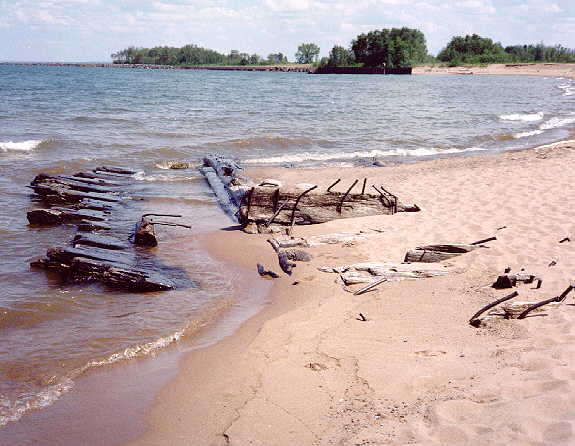
The wreck of the ESSEX courtesy of the Minnesota State Historical Presentation Office
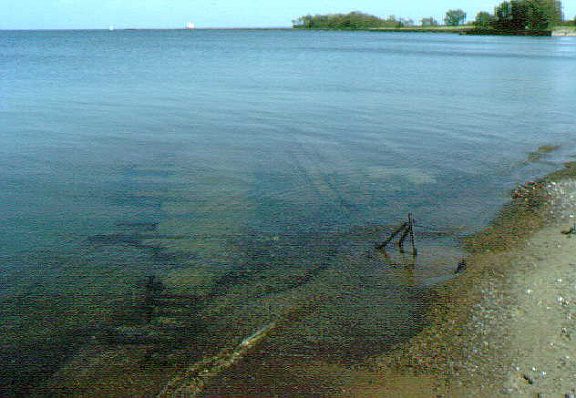
The wreck of the ESSEX courtesy of the Minnesota State Historical Presentation Office
That is where the third US Navy ship to bear the name ESSEX remains today. About 50 feet of her bottom lies buried in the sand, partially exposed from time to time in up to four feet of water. Wikipedia states it “consists of her hull bottom, her keelson, sister keelson, rider keelson, bits of her frame and some hull and ceiling planks. Remains of her engine mount are also present on the site.”
One other part of her remains. One of her masts, possibly the one removed in 1910, served as a flagpole at Camp Perry. Ohio, for many years until it was blown down by a tornado. The Great Lakes Shipwreck Preservation Society recovered a seven foot section of the mast.
USS ESSEX #4 (CV-9) was the class leader of a famous group of 24 fleet aircraft carriers in World War II. USS ESSEX #5 (LHD-2) is a WASP class amphibious assault ship launched in 1991 and currently in service.
——————————–
James Heinz is the Wisconsin Marine Historical Society’s acquisitions director. He became interested in maritime history as a kid watching Jacques Cousteau’s adventures on TV. He was a Great Lakes wreck diver until three episodes of the bends forced him to retire from diving. He was a University of Wisconsin – Milwaukee police officer for thirty years. He regularly flies either a Cessna 152 or 172.

